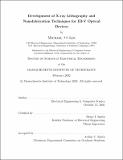| dc.contributor.advisor | Hemry I. Smith. | en_US |
| dc.contributor.author | Lim, Michael H. (Michael Hong) | en_US |
| dc.contributor.other | Massachusetts Institute of Technology. Dept. of Electrical Engineering and Computer Science. | en_US |
| dc.date.accessioned | 2005-05-19T14:38:39Z | |
| dc.date.available | 2005-05-19T14:38:39Z | |
| dc.date.copyright | 2002 | en_US |
| dc.date.issued | 2002 | en_US |
| dc.identifier.uri | http://hdl.handle.net/1721.1/16801 | |
| dc.description | Thesis (Sc. D.)--Massachusetts Institute of Technology, Dept. of Electrical Engineering and Computer Science, 2002. | en_US |
| dc.description | Includes bibliographical references (p. [117]-122). | en_US |
| dc.description | This electronic version was submitted by the student author. The certified thesis is available in the Institute Archives and Special Collections. | en_US |
| dc.description.abstract | This dissertation covers the development of fabrication techniques for Bragg-grating-based integrated optical devices in III-V materials. Work on this rich family of devices has largely been limited to numerical analysis because of the difficulties of their fabrication. The challenges of fabrication are addressed by dividing the problem along two lines: (1) development of an advanced x-ray mask system that addresses future nanolithography needs, and (2) development of fabrication techniques that addresses problems specific to Bragg-grating-based filters. A new x-ray mask configuration is described that improves many aspects of the x-ray mask. A novel means of measuring nondestructively x-ray mask distortion on a global scale was developed, called holographic phase-shifting interferometry (HPSI). This system, in conjunction with appropriate thermal input can potentially provide active correction of x-ray mask distortion. Current microphotonic fabrication issues are presented along with a detailed description of the dual-layer hardmask process (DLHP). The development of the DLHP was specifically geared towards the special requirements of Bragg-grating based microphotonics. Taken as a whole the author hopes that this dissertation serves to facilitate the building of advanced future integrated-optical devices. | en_US |
| dc.description.statementofresponsibility | by Michael Lim. | en_US |
| dc.format.extent | 122 p. | en_US |
| dc.format.extent | 15749517 bytes | |
| dc.format.extent | 15748992 bytes | |
| dc.format.mimetype | application/pdf | |
| dc.format.mimetype | application/pdf | |
| dc.language.iso | eng | en_US |
| dc.publisher | Massachusetts Institute of Technology | en_US |
| dc.rights | M.I.T. theses are protected by copyright. They may be viewed from this source for any purpose, but reproduction or distribution in any format is prohibited without written permission. See provided URL for inquiries about permission. | en_US |
| dc.rights.uri | http://dspace.mit.edu/handle/1721.1/7582 | |
| dc.subject | Electrical Engineering and Computer Science. | en_US |
| dc.title | Development of X-ray lithography and nanofabrication techniques for III-V optical devices | en_US |
| dc.type | Thesis | en_US |
| dc.description.degree | Sc.D. | en_US |
| dc.contributor.department | Massachusetts Institute of Technology. Department of Electrical Engineering and Computer Science | |
| dc.identifier.oclc | 50503702 | en_US |
